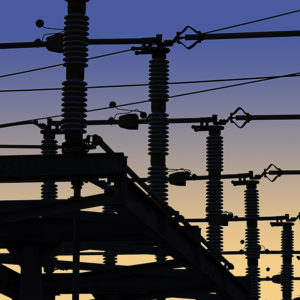A new report from the agency charged with overseeing America’s energy system warns soaring electricity demand is outstripping supply, and current energy policies are making the problem worse.
The report also raises questions about optimistic claims from ISO-New England regarding the region’s grid reliability and “reveals increasing risk of load loss and unserved energy” — aka power shortages and blackouts.
The North American Electric Reliability Corporation (NERC) released its updated Long-Term Reliability Assessment on Tuesday, and its analysis is dire. The combination of increased electrification of power demand and the retirement of baseload power generation from coal and nuclear is creating a real possibility that power demand will outstrip supply.
That problem is being exacerbated by the huge electricity demands of data centers and artificial intelligence (AI).
“Our infrastructure is not being built fast enough to keep up with the rising demand,” said John Moura, NERC’s director of reliability assessment and performance analysis. “Policymakers, industry leaders, and stakeholders across North America must work together to ensure the expansion of the bulk power system, ensure new resources can interconnect effectively and reliably, and also maintain reliability that our society depends on.”
That’s particularly true in New England, which is at “elevated risk…of potential future electricity supply shortfalls under normal and extreme weather conditions,” according to the report.
“New England is forecasting unprecedented demand growth driven by electrification of heating and transportation. New England has among the strongest winter demand forecast growth rates of any assessment area, rising over 7 GW in the 10-year period, or 35 percent from its current peak demand forecast.”
That’s a far greater increase than the narrative from ISO-New England, which projects just a 1.8 percent annual increase in demand and a 17 percent rise in annual energy use by 2033. That is about half the increase projected by NERC.
By projecting a demand increase, the projected amount of electricity required allows ISO-New England to argue that renewables will be able to meet rising demand, a position that’s popular with liberal Democrats who govern most New England states.
However, the NERC report notes that while “new solar PV, battery, and hybrid resources continue to flood interconnection queues, completion rates are lagging behind the need for new generation. Furthermore, the performance of these replacement resources is more variable and weather-dependent than the generators they are replacing.”
NERC’s warning echoes a report released last month by a group of free-market New England organizations including the Josiah Bartlett Center.
“Just as in our study, the NERC report forecasts a huge surge in energy demand at the same time New England state governments try to force a shift to less reliable wind and solar power generation,” Josiah Bartlett Center President Drew Cline said Tuesday. “Both studies show that these trends, if not reversed, will compromise reliability, putting New Englanders at risk of not having enough electricity during periods of peak demand.”
Jim Matheson is CEO of the National Rural Electric Cooperative Association, whose members include the New Hampshire Energy Cooperative.
“NERC’s latest assessment continues painting a grim picture of our nation’s energy future and growing threats to reliable electricity,” Matheson said. “This report points directly to the need for a pro-energy policy agenda that prioritizes reliability and affordability for American families and businesses. We urge President Trump and congressional leaders to prioritize reliability right out of the gate next year before it’s too late.”
The good news for New Hampshire is that 56 percent of its electricity comes from the Seabrook nuclear power plant.
The bad news is, according to the Energy Information Administration, natural gas provided nearly 25 percent of the state’s total electricity generation last year. And while U.S. natural gas production is soaring –and domestic natural gas prices are 62 percent lower than their post-Russia-invasion peak — New Hampshire and New England lack access to more gas to generate more electricity.
The reason? Federal regulations making it nearly impossible to build new pipeline infrastructure to bring the gas from Pennsylvania.
“Potential natural gas transportation constraints can affect supply to generators during extreme cold temperatures, when natural gas demand for space heating is also peaking,” according to the report,
Amanda Eversole with the American Petroleum Institute says New England’s lack of access to natural gas is entirely self-inflicted via politics and policy.
“We have the ability to build pipelines and to make sure we get the natural gas where it needs to go,” Ebersole told NHJournal. “However, based on a variety of state and local policy decisions and a federal permitting system that is deeply in need of reform, we can’t get shovels in the ground.”
Granite State Democrats don’t want to see those pipelines built, arguing the state should pursue renewables like offshore wind. State Rep. Michael Harrington (R-Strafford) says those activists aren’t being honest with ratepayers about the reliability or the cost.
“The problem with offshore wind is that it is very expensive. The latest contracts signed with offshore wind developers in New York are in the $150/MWh range. That’s more than three times the present market rate,” Harrington said.
For example, the Empire Wind project has an agreement to deliver electricity by 2027 at a price of $155 per MWh. “The average wholesale price in New England this August was a little under $39/MWh,” Harrington said.
When more ISO-New England states shift to expensive and unreliable renewables, those costs will be shared across the grid, Harrington notes, including New Hampshire ratepayers. And as subsidizing renewables leads to more fossil-fuel generators to retire, the cost of the remaining baseload power during peak times or weather emergencies is going to soar.
“The trends point to critical reliability challenges facing the industry,” the NERC report concludes. “Satisfying escalating energy growth, managing generator retirements, and accelerating resource and transmission development.”





